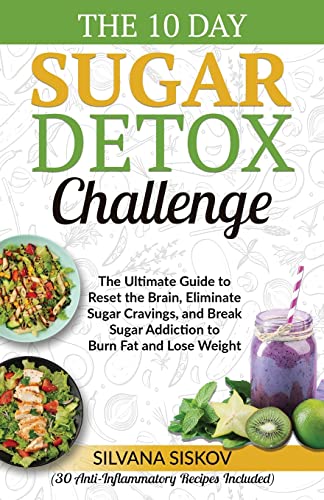Most people have experienced a strong craving for something sweet after a meal or during a mid-afternoon slump. While occasional treats are perfectly fine, constant sugar cravings can make it difficult to maintain a healthy diet and energy balance. Over time, high sugar intake can lead to weight gain, energy crashes, and increased risk for conditions such as diabetes and heart disease.
Learning how to curb your sweet tooth is not about total deprivation—it’s about understanding why you crave sweets and developing habits that help you feel satisfied without overdoing it.
Understanding Why You Crave Sugar
Sugar cravings can stem from several factors, both physiological and psychological. Recognizing the cause makes it easier to manage them effectively.
- Blood Sugar Fluctuations – When you eat refined carbs or sugary snacks, your blood sugar rises quickly and then crashes, triggering new cravings for another energy boost.
- Emotional Triggers – Many people turn to sweets for comfort or stress relief. The temporary serotonin boost from sugar can mimic feelings of calm or happiness.
- Habit and Environment – Sugar often becomes part of daily routines, like grabbing a pastry with coffee or always having dessert after dinner.
- Sleep Deprivation – Poor sleep increases hunger hormones like ghrelin and reduces leptin, leading to a stronger desire for quick energy sources such as sugar.
- Nutrient Deficiencies – Sometimes sugar cravings can signal imbalances, such as low magnesium, which plays a role in glucose metabolism.
Once you understand why your sweet tooth is acting up, you can use targeted strategies to keep it in check.
1. Start with Balanced Meals
A stable blood sugar level is essential for controlling cravings. Focus on meals that combine protein, healthy fats, and complex carbohydrates. This trio keeps you full longer and prevents glucose spikes.
For example:
- Breakfast: Greek yogurt with berries and chia seeds
- Lunch: Grilled chicken salad with olive oil dressing and quinoa
- Dinner: Baked salmon, roasted vegetables, and sweet potatoes
Adding fiber-rich foods like whole grains, beans, and vegetables slows digestion and keeps your energy levels stable throughout the day.
2. Hydrate Before Reaching for Sugar
Dehydration can sometimes be mistaken for hunger or cravings. The next time you want a cookie, drink a glass of water first and wait a few minutes. You may find that your desire for sugar fades. Herbal teas, sparkling water with citrus, or infused water with cucumber and mint can also satisfy your palate without added calories.
3. Prioritize Sleep and Manage Stress
When you are tired or stressed, the body seeks quick energy. Sugar provides an instant dopamine hit, which temporarily improves mood but often leaves you crashing later.
- Sleep: Aim for 7–9 hours per night. A consistent sleep schedule regulates hunger hormones and limits late-night snacking urges.
- Stress management: Try daily stress-reducing techniques such as walking, meditation, yoga, or listening to calming music. Over time, you will notice fewer “comfort sugar” moments.
4. Choose Natural Sweet Alternatives
If you still crave something sweet, opt for healthier substitutes that provide nutrients along with flavor.
- Fresh or frozen fruit—berries, apples, bananas, and dates can satisfy a craving while supplying fiber and vitamins.
- Unsweetened Greek yogurt with a drizzle of honey or cinnamon offers protein and a mild sweetness.
- Stevia, monk fruit, or allulose can add flavor to coffee or tea without the calories or glucose spikes of refined sugar.
The goal is not to eliminate sweetness completely but to replace refined sugar with natural options that support your health.
5. Break the Habit Gradually
Quitting sugar suddenly can be challenging. Instead, reduce intake step by step. For instance:
- Cut sugar in your coffee or tea by half.
- Replace soda with flavored sparkling water.
- Skip dessert two nights per week, then increase gradually.
This steady reduction allows your taste buds to adjust. Within a few weeks, overly sweet foods will start to taste less appealing.
6. Keep Healthy Snacks On Hand
Preparation is key to preventing impulsive sugar fixes. When you keep nutrient-dense snacks available, you’re less likely to reach for candy or pastries.
Smart options include:
- A handful of almonds or walnuts
- Sliced veggies with hummus
- Hard-boiled eggs
- Fresh fruit with nut butter
- Air-popped popcorn with a sprinkle of cinnamon
Having these ready-to-eat snacks handy makes it easier to stay consistent when cravings strike.
7. Read Labels Carefully
Sugar hides in many processed foods under names like dextrose, sucrose, corn syrup, or maltose. Even seemingly healthy items such as granola bars, salad dressings, or flavored yogurts can contain surprising amounts.
When shopping, read ingredient lists and nutrition labels. Choose items with minimal added sugars—ideally less than 5 grams per serving. Over time, this awareness alone can significantly reduce your sugar intake.
8. Eat More Protein
Protein helps stabilize blood sugar levels and prolongs satiety, preventing the quick energy dips that trigger sugar cravings. Include a protein source in each meal:
- Eggs or protein smoothies at breakfast
- Lean poultry or tofu at lunch
- Fish, legumes, or lentils at dinner
If you need a quick post-workout snack, try a protein bar or shake with low sugar content.
9. Train Your Taste Buds
Your palate can adapt to less sweetness. Over time, whole foods begin to taste sweeter naturally. Try adding cinnamon, nutmeg, or vanilla extract to dishes instead of sugar for flavor enhancement.
You may also find that eating more whole fruits instead of juices or desserts satisfies your sweet cravings while supporting your nutrition goals.
10. Distract Yourself During Cravings
Cravings often pass within 10–20 minutes. When you feel one coming on, distract yourself with an activity that shifts your focus:
- Go for a short walk
- Call a friend
- Do light stretching or deep breathing
- Brush your teeth or chew sugar-free gum
These small habits can help retrain your response to cravings and reduce the power sugar holds in your routine.
11. Identify Emotional Triggers
If you often crave sweets when stressed, lonely, or bored, try to address the underlying emotion rather than masking it with food. Keep a journal to track when cravings occur and what emotions are present. Over time, this self-awareness makes it easier to manage triggers more productively.
When emotions arise, consider alternative activities:
- Talk to a friend or family member
- Engage in a creative hobby
- Practice mindfulness or grounding exercises
This emotional regulation approach helps separate food from feelings.
12. Allow Indulgences—But Mindfully
Completely cutting out sugar can backfire, leading to bingeing when willpower fades. Instead, plan occasional treats intentionally. Enjoy dessert when celebrating special moments, but practice mindful eating: take small bites, savor the flavor, and stop when you’ve had enough.
Setting boundaries, such as one dessert per week, allows you to maintain balance without guilt. Remember, moderation creates sustainability.
13. Supplement Wisely
While diet changes come first, certain supplements may help stabilize blood sugar and reduce cravings:
- Magnesium: Supports glucose metabolism and may ease chocolate cravings.
- Chromium picolinate: Assists insulin regulation and carbohydrate processing.
- B vitamins: Aid in energy production and stress resilience.
Consult a healthcare provider before starting new supplements, especially if you have existing health conditions.
14. Be Patient With Yourself
Changing habits takes time. Sugar has addictive properties, and cutting back may initially feel challenging. Celebrate progress instead of perfection. Each day you skip a sugary drink or opt for a healthier dessert alternative is a win.
Set realistic goals, such as reducing added sugar by half within a month, then reassess. Many people notice more stable energy and fewer cravings after just a few weeks of consistent effort.
A Healthier Relationship With Sweetness
Curbing your sweet tooth doesn’t mean saying goodbye to dessert forever. It’s about reclaiming control—knowing when to indulge and when to nourish. As your body adjusts, natural flavors become more satisfying, energy levels even out, and sugar loses its grip.
By balancing your meals, staying hydrated, managing stress, and practicing mindful eating, you can reduce sugar cravings and build a sustainable, healthy lifestyle that still includes the occasional treat.

Claudia Faucher is a full-time fitness training expert and lifestyle blogger. She is also been a certified Les Mills BodyPump instructor for the past 5 years and a fitness instructor for over 20 years. Claudia is a personal trainer and creates fitness training programs for seniors and people of all ages. She likes to use her skills and experiences to help others on their fitness journeys.
Last update on 2025-12-06 / Affiliate links / Images from Amazon Product Advertising API









